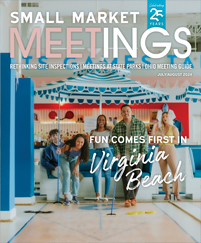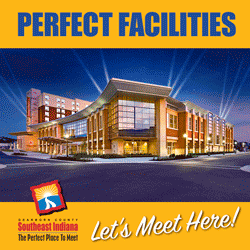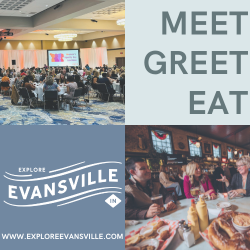Customization is no longer a treat; it’s an expectation. We are used to having everything tailored to our needs and interests, whether it is online ads, coupons tied to our purchasing patterns, or sub sandwiches and burritos made to our specifications.
So it is no surprise that meeting planners want their meetings and events customized. Staffs at convention centers managed by Spectra by Comcast Spectacor say they are ready for the challenge.
Forget the Standard Menus
Katie Conoyer, director of sales and marketing for the St. Charles Convention Center in St. Charles, Missouri, sees demand for customizing most often in the kitchen. Meeting planners have moved away from standardized menus.
“That is the No. 1 change we are seeing,” said Conoyer. “We just had a repeat client in, and they said they didn’t even want to look at our menus.”
Tennille Wanner, director of sales and marketing at the Utah Valley Convention Center in Provo, Utah, agrees. “More and more planners are getting away from standardized menus,” she said. “Really, we now use those menus more as a pricing guide than anything.”
Customization is welcomed by the creative souls who whip up meals in the kitchens of Spectra’s convention centers. Chefs get as tired of the same old, same old as meeting planners and attendees do. “We like to be able to customize,” said Wanner. “Our chef doesn’t want to do the same old chicken dinner.”
Wanner and Conoyer know that at its best, change is driven by more than a whim or boredom. The St. Charles team has conversations with a client before suggesting change-ups from its standard offerings.
“We have a Q&A and talk about what is important to them, what are they looking for, and we ask them what do they want to see,” said Conoyer.
In St. Charles, meeting planners’ desire for change is motivated, in part, by the fact that most have been there before. According to Conoyer, 73 percent of the center’s business is repeat, so it makes sense that many clients are looking for something new and different.
Working Within a Budget
In Provo, the convention center staff enjoys working with groups that are willing to go beyond the routine, but it is important for Wanner and her staff to know about budgets beforehand.
“I always say, ‘What are you used to spending; what do you want to spend?’” Wanner said. After getting an understanding of budget, “I’ll say, ‘Let’s go back and talk to the chef.’”
The center has proved that you don’t have to sacrifice flavor and quality because of budget. Adding ingredients like dried cranberries and nuts is an inexpensive way to dress up a salad. Using a less-expensive but equally flavorful type of steak is another cost saver.
“It might be just changing the cut of meat — a flank steak instead of a filet,” Wanner said. The Provo center’s chef takes the less-expensive flank cut and marinates it in a Korean kalbi sauce. It costs far less than filet, and because it is so flavorful, the entree is as popular as the more expensive cut. The only caveat is that notice is required. “It has to marinate five days,” Wanner said.
Themes Can Elevate Events
Wanner believes that events are elevated by themes. “When events have a theme and are trendy, attendees are apt to have a better time,” she said. “And it is all about what the attendees think and feel when they leave an event.”
Her convention center’s skill at theming events is illustrated by an annual charity gala held there. The gala is a favorite among the center’s staff because it supports a neonatal intensive-care unit.
“We have all become passionate about it,” said Wanner.
The most recent gala had a Tour de Utah theme that covered “everything Utah from north to south,” said Wanner. The catering manager and staff made arches from Styrofoam that replicated Utah’s famous red arches. A cantina served Mexican dishes that are part of local culture. A model of a racecar reminded attendees of the state’s famous Bonneville Salt Flats. Tanks of trout touted Utah’s river fishing. “All of this was built by our catering manager and his crew,” said Wanner.
Each year, a theme is thoroughly carried forth through decor and food. Wanner said her event manager’s desk is typically covered with samples of decor that she has found online; she also rents items needed to ensure an authentic experience.
The effort pays off for the fundraising event. The fundraiser’s profile and attendance have risen since the event has been held at the convention center.
In St. Charles, a client recently requested the feel of a “reveal” and a more active atmosphere at a reception for 250, according to Conoyer. The convention center team created a grand entrance using heavy drapes and six staff members to manually lift them as guests entered. A fog machine allowed guests to appear out of a cloud of “smoke,” like a sports team pouring onto an athletic field.
The St. Charles team also created a series of action stations. “There were stir-fry, carving, potato-bar, salad and dessert stations,” Conoyer said. A mix of seating, including lounge furniture, made the event more upscale.
Local Talent Can Add Color
In Provo, the convention center staff has helped planners find local entertainers ranging from fire dancers to acrobats who dangle from the ceilings on fabric ribbons. “We look for things that will help create an experience,” Wanner said. When the center finds a star, it makes sure to make note so it can suggest the entertainment to other clients.
Keeping a Record for the Future
In St. Charles, Conoyer and her staff keep a running account of each meeting or convention in a shared event summary document. As the event progresses, staff make notes about successes and issues. “We note what works, and what doesn’t,” said Conoyer. The team also meets after the event with the planner and records the planner’s comments.
When events return the following year, as they are likely to do in St. Charles, the staff pulls out the event summary a couple of months beforehand. They study it, put their heads together and brainstorm about changes that can be made to make this year’s event even better than last year’s. It’s not just a way to make a good event better; it’s a way to keep great clients coming back.











